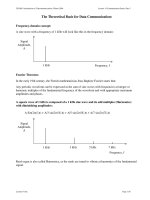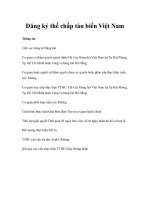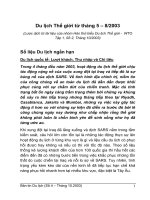Tài liệu Đàn tính The Marvelous and Sarced Musical Instrument of the Tay People- La Công ý pptx
Bạn đang xem bản rút gọn của tài liệu. Xem và tải ngay bản đầy đủ của tài liệu tại đây (384.09 KB, 16 trang )
Asian Ethnology
Volume
, N
umber
•
, –
© Nanzan Institute for Religion and Culture
Đàn tính
The Marvelous and Sacred
Musical Instrument of the Tày People
A đàn tính, the musical instrument of Tày shamans, enables the performance
of a Then (pronouned like the number “ten”) ritual; its music accompanies
the journey of the Then spirit army, and spirits are resident inside the instru-
ment itself. The author, a Tày native scholar, researched the history of the
instrument in relation to the career of the shaman Mrs. Mõ Thị Kịt, the
original owner of the đàn tính displayed in the exhibition, and interviewed
shamans in several other Tày communities. The author also collected infor-
mation from instrument makers and musicians who use the instrument in
secular folk performances. His research distinguishes secular đàn tính from
đàn tính that have been animated with spirits and describes the compromises
that Tày shamans make when they perform sections of their rituals for secular
audiences.
: Vietnam—museum—sacred—Tày ethnicity—material culture—
musical instrument
L C Ý
Vietnam Museum of Ethnology
O
second floor of the Vietnam Museum of Ethnology (), a man-
nequin stands frozen in a dancing posture in front of an elaborately deco-
rated altar for a Then ritual of the Tày people while another mannequin strums a
stringed instrument. Visitors are usually drawn to the accompanying video moni-
tor where, in a video clip of this same ritual, the venerable Then, Mrs. Mõ Thị Kịt,
strums her three-stringed đàn tính.
1
Her assistants shake their brass bells to an
urgent crescendo and rise from the floor in a whirling dance. The Then spirit army
is on the march, going to rescue a client’s errant soul. Mrs. Kịt reports the adven-
tures of their journey through her song. The liveliness of the music and the anima-
tion of the Then women are in marked contrast to the muted three-dimensional
exhibit tableau. Equivalent to the drum in many shamanic cultures, the stringed
đàn tính enables the work of the Then and their spirit familiars. Then say that their
spirits will only descend when they hear the music from the đàn tính and that its
music, like the drum beats in some other shamanic traditions, keeps the Then in
motion for the duration of her journey. According to an elderly Then from Bac
Son district, Lang Son province, “Playing the đàn tính is like beating gongs or
drums to urge troops on the march or to welcome them with processional music
as they enter the banquet hall. If you play the đàn tính but don’t have any food for
the spirit army, you will be punished.”
The đàn tính that Mrs. Kịt strums is the signature musical instrument of the
Tày, Nùng, and Thái people, ethnic minorities living in the north of Vietnam who
speak related languages. It has a gourd body, long wooden neck, and silk strings.
2
In every region where Tày people live, there is someone who knows how to make
a đàn tính. According to a legend recounted by some Then, the Jade Emperor
gave the đàn tính to the Then in order to “save people” through the work of the
rituals that they perform with its aid.
3
Historical documents written in Sino-Tày
(Chinese ideographs used to write Tày language) relate that the đàn tính was
incorporated into court music ensembles at the end of the sixteenth century when
the Mạc dynasty retreated to Cao Bằng province. After the August Revolution in
, many northern provincial performing arts troops used the đàn tính in agit
prop performances. However, the đàn tính is most closely associated with Then
rituals and with the women and men who perform them. During the long period
when these activities were banned as “superstitious,” most Then abandoned their
calling and some discarded their ritual tools by casting them into clear flowing
streams.
4
People avoided any public dealings with those who “carried a đàn tính”
|
Asian Ethnology Volume , Number
•
: |
as propagators of “superstition,” and Then who continued to practice did so in
secret. Đàn tính were rare, and young musicians were not encouraged to learn
how to play them.
Toward the end of the s, following significant policy changes, perceptions
changed. Then rituals are now valued as an important expression of ethnic culture
in many Tày and Thái speaking communities, and đàn tính music has been revived.
Tày people play the đàn tính for pleasure and for celebration. For example, in
some communities they will now play it at weddings where it would not have been
heard in the past. Young people are learning to play the đàn tính, and some dis-
trict and provincial cultural oces have opened training classes. Then ritual mas-
ters are invited to perform on television and at performing arts festivals where
they have won gold and silver medals. Their presence in this new context poses
a paradox. In pure performance, the đàn tính is a secular instrument; however,
. While unused, the Then’s sacred instrument is hung near the Then’s
ancestral altar. La Công Ý,
archive.
|
Asian Ethnology /
•
in the hands of a Then performing a ritual, it is a powerful and potentially danger-
ous instrument of magic.
In this paper, I shall explore the distinction between sacred and secular đàn
tính. How does an ordinary musical instrument become sacred, and what does its
transformed identity imply? Given the special power attributed to the Then’s đàn
tính, and the potential danger of misusing it, I shall also consider how Then are
negotiating the boundaries between sacred ritual and secular performance. In my
conclusion, I will bring this discussion back to the and share my thoughts on
how a sacred đàn tính should be treated as a cultural artifact.
T
t h e n
.
Ị
Ị
đ à n
t í n h
The đàn tính in the collection of the was purchased in from
Mrs. Mõ Thị Kịt
5
, a spry octogenarian and well respected Then who has used it in
many rituals.
6
A resident of Tô Hiệu commune, Bình Gia district, Lạng Sơn prov-
ince, Mrs. Kịt is the most renowned Then in the region and is invited to perform
in the neighboring districts in Đồng Đăng township, Lạng Sơn city, and in the
Võ Nhai district of neighboring Thái Nguyên province. The nine fringes on her
ritual hat indicate that Mrs. Kịt commands many battalions of spirit troops, which
she acquired through three initiations into ascending grades of shamanship. She
has eight apprentices and hundreds of regular clients including not only Tày and
Nùng people but also Kinh (Việt) living in Bìn h Gia township and Yao in some
remote communes in Bình Gia district. Like other Then, Mrs. Kịt is busiest before
. A Then in Bắc Sơn district (Lạng Sơn province) performs a ritual to remove bad
luck that has caused neighbors’ ducks to peck at each other. Magic water in the bowl will
be sprayed onto the ducks. La Công Ý,
archive.
: |
and after the lunar New Year when she says she has to run from place to place,
coming home from one ritual and finding clients waiting to take her to another.
Her son jokes that during this season, her schedule is as busy as that of the district
chief.
While some Then inherit their spirits through a line of family transmission, Mrs.
Kịt, along with many other Then, shares the experience of shamans in other places
who are tormented by the spirits until they agree to accept the spirits’ calling.
When Mrs. Kịt was thirteen years old, she became violently ill and vomited what-
ever she ate. Weak and pale, she was forced to acknowledge her destiny and make
a vow to accept the spirits. Her health improved but when her parents both died a
few years later, she could not aord an initiation ceremony because she was poor
and had used her resources for her parents’ funerals. Because she had failed to
become initiated, her illness returned. Now she would plunge into the river and
spend long hours immersing herself. Once she even extinguished a burning torch
by jumping on it with her bare feet. The signs were clear. When she was eigh-
teen years old, she apprenticed herself to a famous female Then and was initiated
when she was twenty-four years old. Soon after her initiation, she also became her
teacher’s daughter-in-law.
Then like Mrs. Kịt perform a variety of rituals to remove bad luck, prolong
one’s life fate by petitioning the Southern Star to change one’s entry in the book
of life, celebrate longevity, oer wishes for good health, retrieve souls that have
been startled out of the body by falling trees or stones or the cry of a crow, settle
tombs disrupted by bualo or by falling stones or trees, send o the multiple
. A Then in Bình Gia district (Lạng Sơn province) is making magic on
a string so that it can be tied around her client’s wrist to chase away evil spirits.
Her đàn tính rests on the altar behind her. La Công Ý,
archive.
|
Asian Ethnology /
•
souls of the dead, and escort the dead to the realm of the ancestors. They perform
divinations when someone is sick, when small children cry at night, when pigs go
o their feed, and when ducks peck at each other. Although many people express
skepticism about the Then’s work and some will state flat out that it is “useless to
rely on the đàn tính when someone is sick,” others—including some civil servants
who are supposed to shun “superstition”—recount miraculous cures. They will
speak, for example, of a client whom the Thái Nguyên provincial clinic had dis-
missed as hopeless and who was cured after Mrs. Kịt performed a ritual.
7
Mrs Kịt
said, “They must believe because they invite me to perform rituals,” sentiments
echoed by other Then. A member of the land survey administration in Bình Gia
district, a civil servant, lost her eldest child, and when the second was ill she sent
for Mrs. Kịt, who performed a divination and prayed. After the child was cured,
the grateful mother asked Mrs. Kịt to perform a ritual to take away the bad luck,
accepting the Then’s diagnosis of ultimate causes.
Not just a powerful Then who commands many spirit soldiers and performs
powerful magic, Mrs. Kịt is also the best đàn tính performer in the district. She
won a gold medal at a performing arts competition for the eastern provinces and,
. The instrument is disassembled and then reassembled to make it
easy for the Then to transport it. La Công Ý,
archive.









